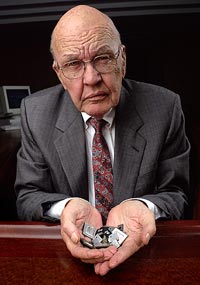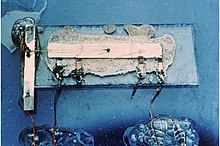Jack Kilby
Jack Kilby
Jump to navigation
Jump to search
| Jack Kilby | |
|---|---|
 | |
| Born | (1923-11-08)November 8, 1923 Jefferson City, Missouri, U.S. |
| Died | June 20, 2005(2005-06-20) (aged 81) Dallas, Texas, U.S. |
| Nationality | United States |
| Alma mater | University of Illinois at Urbana–Champaign University of Wisconsin–Milwaukee |
| Awards | Nobel Prize in Physics (2000) National Medal of Science (1969) IEEE Medal of Honor (1986) Charles Stark Draper Prize (1989) Computer Pioneer Award (1993) Kyoto Prize (1993) Harold Pender Award (2000) |
| Scientific career | |
| Fields | Physics, electrical engineering |
| Institutions | Texas Instruments |
Jack St. Clair Kilby (November 8, 1923 – June 20, 2005) was an American electrical engineer who took part (along with Robert Noyce) in the realization of the first integrated circuit while working at Texas Instruments (TI) in 1958. He was awarded the Nobel Prize in Physics on December 10, 2000.[1] To congratulate him, American President Bill Clinton wrote, "You can take pride in the knowledge that your work will help to improve lives for generations to come."[2]
Kilby is also the co-inventor of the handheld calculator and the thermal printer, for which he has the patents. He also has patents for seven other inventions.[3]
Contents
1 Early life
2 Career
3 Later life
4 Awards and honors
5 Kilby patents
6 See also
7 Notes
8 References
9 External links
Early life[edit]
Jack Kilby was born in 1923 in Missouri to Hubert and Vina Freitag Kilby. His father was an executive with the Kansas Power Company. Kilby grew up and attended school in Great Bend, Kansas, graduating from the Great Bend High School. (Road signs at the entrances to the town commemorate his time there, and the Commons Area at Great Bend High School has been named The Jack Kilby Commons Area.)
Kilby received his bachelor of science degree from the University of Illinois at Urbana–Champaign, where he was an honorary member of Acacia Fraternity. In 1947, he received a degree in electrical engineering. He earned his master of science in electrical engineering from the University of Wisconsin–Milwaukee in 1950, while working at Centralab, a division of Globe-Union corporation in Milwaukee.
Career[edit]
In mid-1958, Kilby, a newly employed engineer at Texas Instruments (TI), did not yet have the right to a summer vacation. He spent the summer working on the problem in circuit design that was commonly called the "tyranny of numbers", and he finally came to the conclusion that the manufacturing of circuit components en masse in a single piece of semiconductor material could provide a solution. On September 12, he presented his findings to company's management, which included Mark Shepherd. He showed them a piece of germanium with an oscilloscope attached, pressed a switch, and the oscilloscope showed a continuous sine wave, proving that his integrated circuit worked, and hence he had solved the problem. U.S. Patent 3,138,743 for "Miniaturized Electronic Circuits", the first integrated circuit, was filed on February 6, 1959.[4] Along with Robert Noyce (who independently made a similar circuit a few months later), Kilby is generally credited as co-inventor of the integrated circuit.
Jack Kilby went on to pioneer military, industrial, and commercial applications of microchip technology. He headed teams that built both the first military system and the first computer incorporating integrated circuits. He later co-invented both the handheld calculator and the thermal printer that was used in portable data terminals.
In 1970, he took a leave of absence from TI to work as an independent inventor. He explored, among other subjects, the use of silicon technology for generating electrical power from sunlight. From 1978 to 1984 he held the position of Distinguished Professor of Electrical Engineering at Texas A&M University.
In 1983, Kilby retired from Texas Instruments.

Jack Kilby's original integrated circuit
Later life[edit]
He died of cancer June 20, 2005 at the age of 81, in Dallas, Texas.
On December 14, 2005, Texas Instruments created the Historic TI Archives. The Jack Kilby family donated his personal manuscripts and his personal photograph collection to Southern Methodist University (SMU). The collection will be cataloged and stored at DeGolyer Library, SMU.
In 2008, the SMU School of Engineering, with the DeGolyer Library and the Library of Congress, hosted a year-long celebration of the 50th anniversary of the birth of the digital age with Kilby’s Nobel Prize-winning invention of the integrated circuit. Symposia and exhibits examined the many ways in which technology and engineers shaped the modern world. Kilby held an honorary doctorate of science from SMU and was a longtime associate of SMU through the Kilby Foundation.
Awards and honors[edit]
Recognition of Kilby’s outstanding achievements have been made by the Institute of Electrical and Electronic Engineers (IEEE), including the election to IEEE Fellow in 1966, the IEEE David Sarnoff Award in 1966,[5] co-recipient of the first IEEE Cledo Brunetti Award in 1978,[6] the IEEE Centennial Medal in 1984 and the IEEE Medal of Honor in 1986.[7] He was co-recipient of the Franklin Institute’s Stuart Ballantine Medal in 1966.[8] In 1982 and 1989, he received the Holley Medal from the American Society of Mechanical Engineers (ASME).[9] He was elected to member of the National Academy of Engineering (NAE) in 1967,[10] received the Academy’s Vladimir K. Zworykin Award in 1975, and was co-recipient of the first NAE’s Charles Stark Draper Prize in 1989.[11]The Kilby Award Foundation was founded in 1980 in his honor, and the IEEE Jack S. Kilby Signal Processing Medal was created in 1995.
Kilby is also the recipient of the nation’s most prestigious honors in science and engineering: the National Medal of Science in 1969, and the National Medal of Technology in 1990. In 1982, he was inducted into the National Inventors Hall of Fame.
In 1993, he was awarded the Kyoto Prize by the Inamori Foundation. He was awarded both the Washington Award, administered by the Western Society of Engineers and the Eta Kappa Nu Vladimir Karapetoff Award in 1999. In 2000, Kilby was awarded the Nobel Prize in Physics for his breakthrough discovery, and delivered his personal view of the industry and its history in his acceptance speech.
Kilby was awarded nine honorary doctorate degrees from universities including Southern Methodist University, the University of Miami, University of Illinois, University of Wisconsin-Madison, Texas A&M University, Yale and Rochester Institute of Technology. The National Chiao Tung University (NCTU) in Taiwan awarded Kilby with a certificate of Honorary Professorship in 1998.
The Kilby Center, TI's research center for silicon manufacturing, is named after him.
The Jack Kilby Computer Centre at the Merchiston Campus of Edinburgh Napier University in Edinburgh is also named in his honor.[12]
Kilby patents[edit]
U.S. Patent 2,892,130 Plug-in Circuit Units, filed December 1953, issued June 1959, assigned to Globe-Union, Inc.
U.S. Patent 3,072,832 Semiconductor Structure Fabrication, filed May 1959, issued January 1963
U.S. Patent 3,115,581 Miniature Semiconductor Integrated Circuit, filed May 1959, issued December 1963
U.S. Patent 3,138,721 Miniature Semiconductor Network Diode and Gate, filed May 1959, issued June 1964
U.S. Patent 3,138,743 Miniaturized Electronic Circuits, filed February 6, 1959, issued June, 1964
U.S. Patent 3,138,744 Miniaturized Self-contained Circuit Modules, filed May 1959, issued June 1964
U.S. Patent 3,435,516 Semiconductor Structure Fabrication, filed May 1959, issued April 1969
U.S. Patent 3,496,333 Thermal Printer, filed October 1965, issued February 1970
U.S. Patent 3,819,921 Miniature Electronic Calculator, originally filed September 1967, issued June 1974
See also[edit]
| Wikiquote has quotations related to: Jack Kilby |
Geoffrey Dummer, the British engineer who first conceived the idea of the integrated circuit.
Notes[edit]
^ The Nobel Prize in Physics 2000. Nobelprize.org. Retrieved on 2013-11-21.
^ "Jack Kilby". TI. Retrieved 27 May 2014..mw-parser-output cite.citation{font-style:inherit}.mw-parser-output q{quotes:"""""""'""'"}.mw-parser-output code.cs1-code{color:inherit;background:inherit;border:inherit;padding:inherit}.mw-parser-output .cs1-lock-free a{background:url("//upload.wikimedia.org/wikipedia/commons/thumb/6/65/Lock-green.svg/9px-Lock-green.svg.png")no-repeat;background-position:right .1em center}.mw-parser-output .cs1-lock-limited a,.mw-parser-output .cs1-lock-registration a{background:url("//upload.wikimedia.org/wikipedia/commons/thumb/d/d6/Lock-gray-alt-2.svg/9px-Lock-gray-alt-2.svg.png")no-repeat;background-position:right .1em center}.mw-parser-output .cs1-lock-subscription a{background:url("//upload.wikimedia.org/wikipedia/commons/thumb/a/aa/Lock-red-alt-2.svg/9px-Lock-red-alt-2.svg.png")no-repeat;background-position:right .1em center}.mw-parser-output .cs1-subscription,.mw-parser-output .cs1-registration{color:#555}.mw-parser-output .cs1-subscription span,.mw-parser-output .cs1-registration span{border-bottom:1px dotted;cursor:help}.mw-parser-output .cs1-hidden-error{display:none;font-size:100%}.mw-parser-output .cs1-visible-error{font-size:100%}.mw-parser-output .cs1-subscription,.mw-parser-output .cs1-registration,.mw-parser-output .cs1-format{font-size:95%}.mw-parser-output .cs1-kern-left,.mw-parser-output .cs1-kern-wl-left{padding-left:0.2em}.mw-parser-output .cs1-kern-right,.mw-parser-output .cs1-kern-wl-right{padding-right:0.2em}
^ "The Chip that Jack Built". IT Invention. Retrieved 27 May 2014.
^ "The Nobel Prize in Physics 2000". Nobel Foundation. Retrieved 2011-07-14.
^ "IEEE David Sarnoff Award Recipients" (PDF). IEEE. Retrieved December 6, 2011.
^ "IEEE Cledo Brunetti Award Recipients" (PDF). IEEE. Retrieved December 6, 2011.
^ "IEEE Medal of Honor Recipients" (PDF). IEEE. Archived from the original (PDF) on 2015-04-22. Retrieved December 6, 2011.
^ "Franklin Laureate Database - Stuart Ballantine Medal 1966 Laureates". Franklin Institute. Archived from the original on 2012-12-10. Retrieved December 6, 2011.
^ "Holley Medal". American Society of Mechanical Engineers. Retrieved December 6, 2011.
^ "NAE Members Directory - Mr. Jack S. Kilby". National Academy of Engineering. Retrieved December 6, 2011.
^ "Recipients of The Charles Stark Draper Prize". National Academy of Engineering. Retrieved December 6, 2011.
^ "School of Computing - Facilities & Resources". Edinburgh Napier University. Retrieved July 24, 2012.
References[edit]
Berlin, Leslie The man behind the microchip: Robert Noyce and the invention of Silicon Valley Publisher Oxford University Press US, 2005
ISBN 0-19-516343-5
- Lécuyer, Christophe. Making Silicon Valley: Innovation and the Growth of High Tech, 1930-1970 Published by MIT Press, 2006.
ISBN 0262122812
Nobel lectures, World Scientific Publishing Co., Singapore, 2000.
External links[edit]
| Wikinews has related news: Jack Kilby, Nobel laureate and inventor of integrated circuit, dies at 81 |
Honoring Jack Kilby website, with resource archive of articles, Kilby statue in Great Bend, KS etc.
"Jack St. Clair Kilby: A Man of Few Words", biography by Ed Millis.
"Video about Jack Kilby" on YouTube, video presentation from Texas Instruments.
"Jack St. Clair Kilby", biography by Texas Instruments.
Oral history interview with Jack S. Kilby at Charles Babbage Institute, University of Minnesota, Minneapolis. Interview covers Kilby's entire career, including his education, work experiences at Centralab, where he worked with Alfred Khouri and Robert Wolff, and Texas Instruments (TI) under Willis Adcock. Kilby discusses TI's development and manufacturing of integrated circuits. He discusses his involvement in the development of the first hand-held calculator at TI. Discusses semiconductor developments at Fairchild Corporation and his independent work after leaving TI in 1970.
"Jack Kilby, Touching Lives on Micro and Macro Scales" by T.R. Reid, The Washington Post (June 2005).
Obituary: The Economist, Jul 7th 2005]
Jack Kilby at Find a Grave
- Nobelprize.org posts Mr Kilby’s Nobel lecture
Jack S. Kilby, a brief autobiography at the Wayback Machine (archived February 28, 2006)- Jack S. Kilby Patents
- Inventors of the Modern Computer
- Nobel Prize in Physics 2000
"IEEE Global History Network - Jack Kilby: Biography". IEEE. Retrieved March 2, 2011.
The Chip That Jack Built, a short film by public television station KERA profiling Kilby
"Tribute to Jack Kilby", Dream 2047, November 2005
Categories:
- 1923 births
- 2005 deaths
- American inventors
- People from Jefferson City, Missouri
- University of Illinois at Urbana–Champaign alumni
- University of Wisconsin–Milwaukee alumni
- American electronics engineers
- American electrical engineers
- Nobel laureates in Physics
- American Nobel laureates
- IEEE Medal of Honor recipients
- National Medal of Technology recipients
- National Medal of Science laureates
- Texas Instruments people
- Deaths from cancer in Texas
- Amateur radio people
- Draper Prize winners
- Scientists from Kansas
- IEEE Centennial Medal laureates
- Fellow Members of the IEEE
- Members of the United States National Academy of Engineering
- National Inventors Hall of Fame inductees
(window.RLQ=window.RLQ||).push(function(){mw.config.set({"wgPageParseReport":{"limitreport":{"cputime":"0.796","walltime":"0.981","ppvisitednodes":{"value":6007,"limit":1000000},"ppgeneratednodes":{"value":0,"limit":1500000},"postexpandincludesize":{"value":257992,"limit":2097152},"templateargumentsize":{"value":6594,"limit":2097152},"expansiondepth":{"value":18,"limit":40},"expensivefunctioncount":{"value":9,"limit":500},"unstrip-depth":{"value":1,"limit":20},"unstrip-size":{"value":33097,"limit":5000000},"entityaccesscount":{"value":1,"limit":400},"timingprofile":["100.00% 629.239 1 -total"," 27.14% 170.805 1 Template:Infobox_scientist"," 25.38% 159.695 1 Template:Infobox_person"," 22.78% 143.329 1 Template:Reflist"," 20.34% 127.988 2 Template:Infobox"," 20.13% 126.688 12 Template:Cite_web"," 11.19% 70.380 9 Template:Navbox"," 6.97% 43.883 1 Template:Nobel_Prize_in_Physics_Laureates_1976-2000"," 6.93% 43.610 5 Template:Br_separated_entries"," 6.64% 41.789 1 Template:Find_a_Grave"]},"scribunto":{"limitreport-timeusage":{"value":"0.238","limit":"10.000"},"limitreport-memusage":{"value":6350309,"limit":52428800}},"cachereport":{"origin":"mw1325","timestamp":"20181125223339","ttl":86400,"transientcontent":true}}});});{"@context":"https://schema.org","@type":"Article","name":"Jack Kilby","url":"https://en.wikipedia.org/wiki/Jack_Kilby","sameAs":"http://www.wikidata.org/entity/Q182031","mainEntity":"http://www.wikidata.org/entity/Q182031","author":{"@type":"Organization","name":"Contributors to Wikimedia projects"},"publisher":{"@type":"Organization","name":"Wikimedia Foundation, Inc.","logo":{"@type":"ImageObject","url":"https://www.wikimedia.org/static/images/wmf-hor-googpub.png"}},"datePublished":"2002-07-24T17:15:20Z","dateModified":"2018-11-20T16:01:41Z","image":"https://upload.wikimedia.org/wikipedia/en/c/cc/Jack_Kilby.jpg","headline":"American electrical engineer"}(window.RLQ=window.RLQ||).push(function(){mw.config.set({"wgBackendResponseTime":111,"wgHostname":"mw1270"});});


